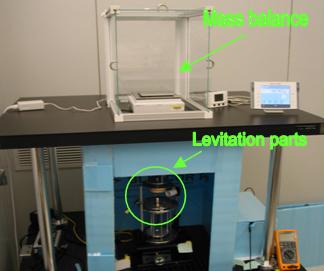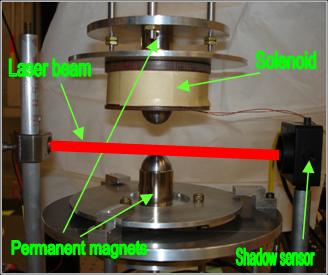| * |
|
An Alternative Approach to Mass Metrology
Summary:
In anticipation of the redefinition of the kilogram and to avoid a parallel non-SI dissemination system for mass, an alternative approach to mass measurement is being developed at NIST. Magnetic levitation is utilized to create a mass comparison system in which a test mass artifact in air can be directly compared to a standard mass artifact in vacuum using the same high precision comparator balance. Due to the extreme sensitivity of this comparator balance (in the order of 10 μg), any change in temperature near the balance may affect measurement results. Therefore, permanent magnets will be used in this project to achieve the levitation. A solenoid is added to the system to stabilize the magnetic levitation. To test the feasibility of this project, a levitation system has been constructed as shown in Figure 1.
 This is a photograph of the proof-of-concept apparatus. For simplicity, the proof-of-concept apparatus was constructed with both masses in air at atmospheric pressure. Two attractive permanent magnets are used to make the levitation. A solenoid is added to the system to stabilize the magnetic levitation.
 The is a photograph of the close-up of the levitation parts in the proof-of-concept apparatus. The vertical position signal is provided by a "shadow sensor" photodiode that detects a laser beam that just skims the top of the magnetic pole that is attached to the levitated assembly.
Description:According to Earnshaw's theorem, stable magnetic levitation cannot be achieved by using only permanent magnets. It is necessary to add an active feedback control to regulate the perturbation affecting the system. When the controller is initiated, the vertical position signal Vactual is servo controlled about a desired equilibrium position corresponding to an output Vdesired of the shadow sensor. That is, based on the difference of Vactual to Vdesired, the controller provides an input V0 for the current power supply to maintain stable levitation. The current power supply provides a current i to the solenoid based on the input voltage V0. The magnetic field produced by the solenoid exerts an attractive force on the levitated body and raises it to position x. The shadow sensor detects this position and provides an output in the form of a voltage Vactual. The block diagram of this system in an open loop with input V0 and output Vactual is shown in Figure
We modeled different components of this system separately. Using the first order Taylor series expansion of the equation of motion, plant model was derived to be a second order linear differential equation. Power supply and shadow sensor models are both determined experimentally to be linear. Using these models, a PID (proportional, integral, and derivative position loop) controller was established. This controller was then applied digitally to the levitation apparatus to produce an automatic stable levitation with a vertical position oscillation of 3.4 μm around the desired levitation distance. On this balance of 1 mg accuracy, steady measurement is achieved using the proposed controller. For the construction of NIST's next generation magnetic levitation balance with bigger mass and stronger magnets, computer experiments were run on a surrogate-FEA computational black boxes MagNet so as to gain insight into dominant factors as well as deduce optimal settings. We utilized important functionalities like scripting, parameterization and interoperability of MagNet to conduct computer experiments efficiently. Verification and Validation were performed to checks that MagNet meets specifications and that it fulfills its intended purpose. We used factorial designs to study multiple factors simultaneous to optimize the magnetic force gradient and the distance between magnetic poles. The factors studied include coercivity of the magnets, the shape of the magnetic poles and the current for the solenoid. |
Lead Organizational Unit:pmlCustomers/Contributors/Collaborators:
Patrick Abbott, Zeina Jabbour, Joe Chalfoun
(Manufacturing Metrology Division, MEL, NIST), Ruimin Liu, Edwin Williams (Quantum Electrical Metrology Division, EEEL, NIST) and James Filliben, Antonio Possolo (Statistical Engineering Division, ITL, NIST) Staff:
Hung-kung Liu, ITL
Contact
Hung-kung Liu |

